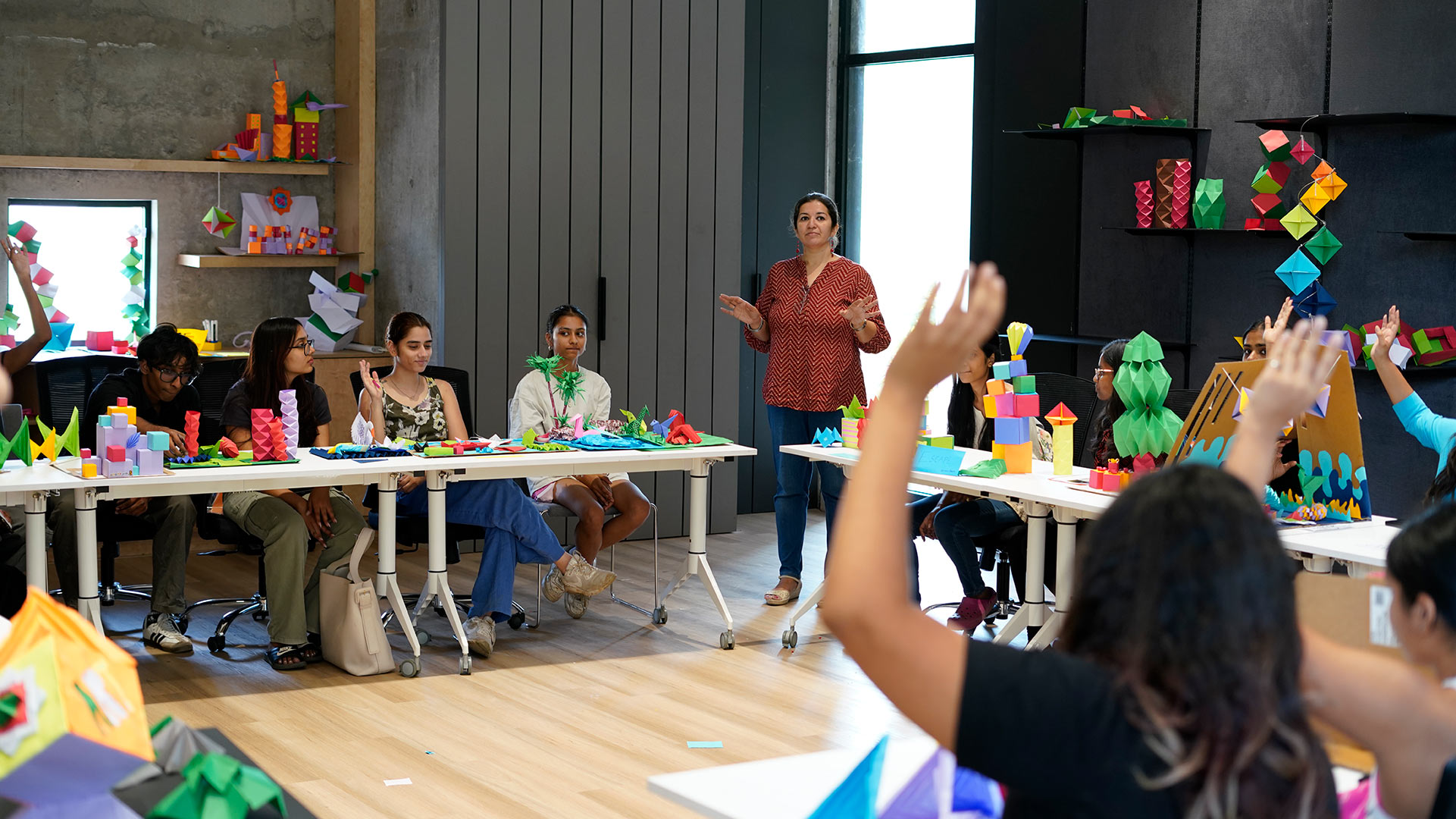VOICE OF FLAME


Major in Design Management: Merging Creativity and Strategy
Every enthusiastic first-year student at FLAME has a big decision to make: ‘What major should I choose?’ This choice requires you to introspect and identify your passions, competencies, and interests. When I was presented with the opportunity to declare my major, I found myself torn between my love for creative exploration and my fascination with business strategy. I've always loved sketching ideas, brainstorming solutions, and bringing concepts to life. At the same time, I’m intrigued by how businesses operate, how strategic decisions are made, and how those decisions can shape an entire industry. I wanted to learn how to bring these two worlds together.
Discovering Design Management at FLAME University
When I first came across Design Management, I wasn’t entirely sure what it entailed. I imagined it might involve managing designers or overseeing creative projects. As I delved deeper into the program at FLAME University, I realized it’s so much more than that. Design Management is about using design as a strategic tool that can drive innovation, enhance customer experiences, and help businesses solve complex challenges creatively and effectively.
Through this program, I’ve come to understand that design isn’t just about aesthetics. It’s about how things work, how they make people feel, and how they can solve real-world problems. I’ve learned to see design as a powerful force that, when managed strategically, can transform businesses and create value on multiple levels.
As I became a design student, I learned that failure is not something that we should avoid; instead, it is an essential part of the process that allows us to continuously grow. The program has taught me the value of rapid prototyping and iteration-building something quickly, testing it, learning from it, and refining it. Group assignments and working in teams have taught me that, at its core, collaboration is about understanding people-truly listening to their needs, frustrations, and desires.
This program isn’t just about studying-it’s about discovering yourself, finding your unique voice, and learning how to use it to make a difference.
Choosing My Major: Why Design Management Was the Perfect Choice Choosing Design Management as my major was driven by a desire to bridge the gap between creativity and business strategy. This is where design thinking fuels business innovation, and where I’ve learned that solving problems isn’t just about coming up with clever ideas-it’s about creating meaningful change. I have been able to gain a unique skill set and a broad, comprehensive perspective that I think would not have been possible elsewhere.
Choosing Design Management as my major was driven by a desire to bridge the gap between creativity and business strategy. This is where design thinking fuels business innovation, and where I’ve learned that solving problems isn’t just about coming up with clever ideas-it’s about creating meaningful change. I have been able to gain a unique skill set and a broad, comprehensive perspective that I think would not have been possible elsewhere.
- Learning from Inspiring Faculty: Our professors are not just academics; they are industry veterans who bring real-world experiences into the classroom. I have had the privilege of learning from faculty members who have collaborated with some of the most renowned professionals in the field. Their insights have been invaluable. They not only teach us theories but also share stories from their personal experiences, connect us with industry professionals, and guide us through the challenges of managing design in dynamic environments.
- Access to World-Class Infrastructure: FLAME’s design studio is a place where I’ve spent countless hours brainstorming, sketching, and prototyping ideas. It’s more than just a space-it’s an ecosystem that fosters creativity and collaboration. Equipped with the latest tools and technologies, the studio has become my playground for experimentation. From digital tools to traditional prototyping materials, it offers everything needed to bring ideas to life. This hands-on experience has been crucial in helping me understand the practical aspects of Design Management.
- Meaningful Industry Connections: Another highlight of the program is the strong network of industry connections that the faculty brings to the table. We regularly attend guest lectures, workshops, and live projects where we get to interact with industry leaders and practitioners. I have had the opportunity to work on projects through design hackathons, pop-up schools, and industry projects. It gave me firsthand insight into the implementation of design strategies in the real world and what it takes to drive innovation in a business context.
Applying my learnings: A Design Hackathon When I first started the Design Management program, one of my most defining experiences was participating in a design hackathon organized by Two Collaborate. The project involved developing a service concept for Connectix Toys, and I remember feeling excited yet overwhelmed by the complexity of the challenge. It wasn’t just about coming up with a creative toy concept; we had to think about the bigger picture-how this service would impact the business, how it could meet consumer needs, and how it could stand out in a competitive market.
When I first started the Design Management program, one of my most defining experiences was participating in a design hackathon organized by Two Collaborate. The project involved developing a service concept for Connectix Toys, and I remember feeling excited yet overwhelmed by the complexity of the challenge. It wasn’t just about coming up with a creative toy concept; we had to think about the bigger picture-how this service would impact the business, how it could meet consumer needs, and how it could stand out in a competitive market.
Over the course of the hackathon, my team and I went through several stages of design thinking-empathizing with the users, defining the problem, ideating, prototyping, and testing. I was struck by how we had to keep balancing creativity with practicality. It wasn’t enough to create something imaginative; we needed to ensure our ideas aligned with business goals and could be implemented efficiently. I took on the role of synthesizing user research and aligning it with business strategy, which allowed me to see how design management operates at the intersection of innovation and execution.
The process was intense. We spent hours in brainstorming sessions, sketching out ideas, and building prototypes, but what truly stood out to me was the iterative nature of the work. We tested our concepts multiple times, constantly refining them based on feedback from mentors and users. This taught me the importance of rapid prototyping-building something quickly, testing it, and learning from failure. I realized that failure wasn’t something to fear, but an opportunity to learn and improve.
The experience also deepened my understanding of teamwork and collaboration. I saw firsthand how diverse perspectives contributed to richer solutions, and I learned the importance of listening-really listening-to understand people’s needs and frustrations. This is where the human-centered design aspect came into play, helping us shape a service that was not only innovative but meaningful to the users.
By the end of the hackathon, we had created a service concept that not only resonated with the target audience but also aligned with Connectix Toys’ business goals. This was a pivotal moment for me. It solidified my understanding that Design Management is much more than overseeing creative projects-it's about driving innovation, solving complex problems, and creating value that bridges the gap between creativity and strategy. This experience empowered me to think not just as a designer, but as a strategic thinker capable of shaping business solutions through design.
A Career Fueled by Design and Strategy
Specializing in Design Management has equipped me with a unique blend of creative and strategic skills that I believe will be invaluable in my career. I’m excited about the endless possibilities that lie ahead—whether it’s working as a design strategist, driving innovation in a large corporation, or even starting my venture. I know that whatever I do, whatever field I join, I will be approaching everything with a creative mindset and a deep commitment to making a meaningful impact. My journey will be fueled by curiosity, collaboration, and a desire to solve complex challenges in innovative ways.
(Author: Vedanti Dutt, Undergraduate Student)






